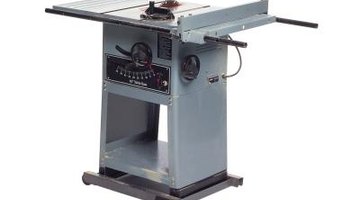How to Cut a 2x2 on Diagonal With a Table Saw
Cutting a board diagonally on a table saw sounds easy -- until you lay the board on the table and realize you can't just set an angled fence and slide the board through the blade. Instead, you must use some method of holding the board at a precise angle as it moves through the blade. The longer the 2-by-2, the shallower the cut angle. Complicating matters, the entire setup must move along with the board to make the cut.

Step 1
Set the table saw fence 3 inches from the blade, which is twice the width of a 2-by-2. Start the saw and cut a piece of plywood 3 inches wide using the fence as a guide. Turn the saw off. (Note: A 2-by-2 is dimensional lumber that measures 1 1/2 inches wide.)
Step 2
Set the 2-by-2 on the plywood with one end flush with the plywood end and the left edge of the plywood and the opposite end of the 2-by-2 flush with the right side of the plywood. Mark the edge of the 2-by-2 on the plywood and remove the 2-by-2.
Step 3
Apply double-sided tape to the plywood piece along the marked line. Remove the tape backing. Place the 2-by-2 on top of the tape, with the edge aligned with the marked line. Press the 2-by-2 firmly onto the tape.
Step 4
Place the plywood on the table saw with the right edge against the fence. Set the fence so the table saw blade aligns with the leading corner of the 2-by-2.
Step 5
Start the saw and feed the plywood and 2-by-2 through the blade while keeping the edge of the plywood against the fence. The plywood will have a straight cut, but the 2-by-2 will be cut in two diagonally between opposite corners.
Resources
Tips
- This method wastes a piece of plywood but is easy to do and works for any length of 2-by-2 that is equal to or shorter than the length of the plywood.
- If you have many pieces of 2-by-2 to cut like this, make a plywood strip a 2 feet longer than the 2-by-2s. Cut a center slot with the saw, align opposite corners of the 2-by-2 with the slot and cut the pieces. Change the tape for each cut.
Warnings
- Wear appropriate safety gear, including a dust mask and eye protection. Use push sticks to move the boards through the saw and keep all body parts 6 inches or more from the spinning blade.
Writer Bio
Michael Logan is a writer, editor and web page designer. His professional background includes electrical, computer and test engineering, real estate investment, network engineering and management, programming and remodeling company owner. Logan has been writing professionally since he was first published in "Test & Measurement World" in 1989.
Photo Credits
- Comstock/Comstock/Getty Images
More Articles



